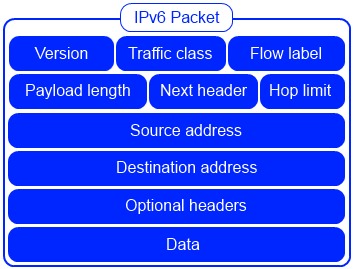This page shows to you the main differences between
IPv4
and
IPv6
. I hope it is useful to you.
Packets
IPv4 packet
and
IPv6 packet


Addresses
Address on IPv4
32 bits (4 bytes)
12:34:56:78
Address on IPv6
128 bits (16 bytes)
1234:5678:9abc:def0:
1234:5678:9abc:def0
Packets size
Packet size on IPv4
576 bytes required,
fragmentation optional
Packet size on IPv6
1280 bytes required
without fragmentation
Packets fragmentation
Fragmentation on IPv4
Routers and sending hosts
Fragmentation on IPv6
Sending hosts only
Packets header
Header on IPv4
Does not identify packet flow for QoS handling
Includes a checksum
Includes options up to 40 bytes
Header on IPv6
Contains Flow Label field that specifies packet flow for QoS handling
Does not include a checksum
Extension headers used for optional data
DNS records
DNS records on IPv4
Address (A), maps host names
Pointer (PTR), IN-ADDR.ARPA DNS domain
DNS records on IPv6
Address (AAAA), maps host names
Pointer (PTR), IP6.ARPA DNS domain
Addresses configuration
Addresses configuration on IPv4
Manual or via DHCP
Addresses configuratiion on IPv6
Stateless address autoconfiguration (SLAAC) using Internet Control Message Protocol version 6 (ICMPv6) or DHCPv6
IP to MAC resolution
IP to MAC resolution on IPv4
broadcast ARP
IP to MAC resolution on IPv6
Multicast Neighbor Solicitation
Local subnet group management
Local subnet group management on IPv4
Internet Group Management Protocol (IGMP)
Local subnet group management on IPv6
Multicast Listener Discovery (MLD)
Broadcast
Broadcast on IPv4
Yes
Broadcast on IPv6
No
Multicast
Multicast on IPv4
Yes
Multicast on IPv6
Yes
IPSec
IPSec on IPv4
optional, external
IPSec on IPv6
required